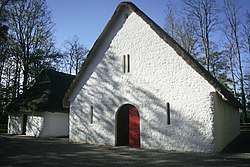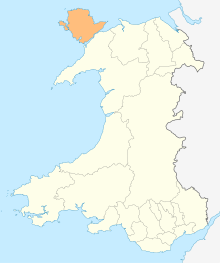Llys Rhosyr
Llys Rhosyr, also known as "Cae Llys",[1] is an archaeological site near Newborough in Anglesey; the ruins of a pre-Edwardian commotal court. The Welsh word llys originally referred to an enclosed open-air space but gradually took on the meaning of a place where legal proceedings took place and was gradually extended to refer to royal "courts".[2]

Llys Rhosyr was a commotal centre before Edward I of England's conquest of Wales and debate now surrounds the former use of the Rhosyr site.[3] Archaeologists at Gwynedd Archaeological Trust consider it to have been a royal home and have established an exhibition in the Pritchard-Jones Institute in the village on their findings supporting this theory. Excavations reveal that the enclosure had a hall, accommodation and storage barns, originally built in stone and wood. The buildings may have occupied an area as much as 450 by 300 feet (137 m × 91 m).[4]
A fierce sandstorm in the winter of 1332 buried the site and much of the surrounding area, which may have caused the decline in activity during the 14th century revealed by the archaeological investigation.[5] When Henry Rowlands was writing in the early 18th century, the sands had uncovered parts of the walls, but no significant remains were visible, though he comments that local people were aware of the location and nature of the remains, a site sometimes known as 'llys' or 'cae'r llys' ('the field of the court' in English).[6]
From 1992 it was excavated by the Gwynedd Archaeological Trust and was opened to the public for the first time in 1995. What remains is the outlines of the walls, around only a quarter of which are exposed, including the main surrounding wall and foundations and lower walls of three large buildings, possibly the hall, a chamber and storage barns. Many artifacts were recovered from the site, including pottery and silverware indicating use by people of a high social status, as well as lead fishing weights.[5] It is the only royal court of Gwynedd whose site has so far been excavated.[4]
Reconstruction at St Fagans
A reconstruction of the Great Hall of Llys Rhosyr was built as part of the redevelopment of St Fagan's National History Museum, Cardiff, using a grant from the Heritage Lottery Fund awarded in 2012. It was proposed that the building, with its 9-metre-high (30 ft) walls, would be able to accommodate groups overnight on completion.[7] The hall and the nearby chamber were modelled on the two most thoroughly excavated buildings on the original site.[1]

The building was opened to the public in October 2018 and the first group of visitors to spend the night were children and teachers from Ysgol Santes Dwynwen School in Newborough, Anglesey, in May 2019.[8]
References
- "Cae Llys, Rhosyr, Newborough". Coflein. Retrieved 9 March 2020.
- John T. Koch; Barry Cunliffe (1 September 2016). Celtic from the West 3: Atlantic Europe in the Metal Ages - questions of shared language. Oxbow Books. p. 283. ISBN 978-1-78570-230-3.
- Aris, Mary (2019). Rhosyr – Its History and Topography in the Age of the Welsh Princes. Troubador Books, Leicester.ISBN 978 1789016 673).
- Sarah Woodbury (6 November 2018). This Small Corner of Time: The After Cilmeri Series Companion. The Morgan-Stanwood Publishing Group. p. 56.
- Alan Lane; Mark Redknap (28 February 2020). Llangorse Crannog: The Excavation of an Early Medieval Royal Site in the Kingdom of Brycheiniog. Oxbow Books. p. 394. ISBN 978-1-78925-307-8.
- Royal Commission on the Ancient and Historical Monuments and Constructions in Wales and Monmouthshire (1956). An Inventory of the Ancient Monuments in Caernarvonshire: West: the cantref of Lleyn, together with the general survey of the country. HMSO. p. cxliii.
- "One of Wales' favourite museums is having a big revamp and this is what you can expect". Wales Online. 5 December 2016. Retrieved 15 July 2018.
- "First ever medieval sleepover at St Fagans National Museum of History". National Museum of Wales - Press Releases. 16 May 2019. Retrieved 21 August 2019.
